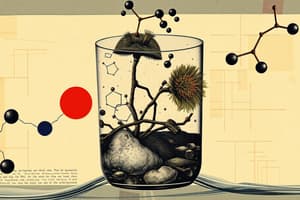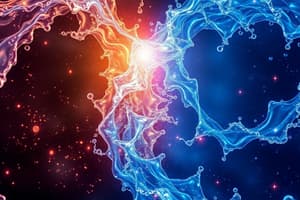Podcast
Questions and Answers
Which of the following is a trace element required by most living organisms?
Which of the following is a trace element required by most living organisms?
- Iron
- Magnesium (correct)
- Zinc
- Copper
What is hydrogen bonding most often seen with?
What is hydrogen bonding most often seen with?
When hydrogen is covalently bonded to an electronegative atom.
What happens when chemical equilibrium is reached?
What happens when chemical equilibrium is reached?
The forward and reverse reactions occur at the same rate.
Which property of water allows a paper towel to pick up a puddle of water?
Which property of water allows a paper towel to pick up a puddle of water?
Identify all correct statements about the ionization of water.
Identify all correct statements about the ionization of water.
In the term trace element, what does the adjective trace mean?
In the term trace element, what does the adjective trace mean?
What does the reactivity of an atom arise from?
What does the reactivity of an atom arise from?
Which of the following bonds can form between atoms of equal electronegativity?
Which of the following bonds can form between atoms of equal electronegativity?
What does the term electron orbital describe?
What does the term electron orbital describe?
What is a true statement about weak bonds?
What is a true statement about weak bonds?
What happens during the decay of radioactive isotopes?
What happens during the decay of radioactive isotopes?
What is the half-life?
What is the half-life?
What is radiometric dating?
What is radiometric dating?
What is potential energy?
What is potential energy?
Why are radioactive isotopes useful in scientific research?
Why are radioactive isotopes useful in scientific research?
What type of bond is formed when valence electrons are shared by two neutral atoms?
What type of bond is formed when valence electrons are shared by two neutral atoms?
What is the role of van der Waals interactions in biological molecules?
What is the role of van der Waals interactions in biological molecules?
What is a true statement about chemical reactions?
What is a true statement about chemical reactions?
Flashcards are hidden until you start studying
Study Notes
Trace Elements
- Magnesium is a trace element that constitutes about 0.1% by weight in most living organisms.
- Trace elements are necessary in very small amounts for different life forms, with iron being essential for all forms of life.
Hydrogen Bonding
- Hydrogen bonds occur when hydrogen is covalently bonded to an electronegative atom.
- Electronegativity creates a slight positive charge on hydrogen, attracting it to other electronegative atoms, forming bonds.
Chemical Equilibrium
- Achieved when forward and reverse reactions occur at the same rate, maintaining constant concentrations of reactants and products.
Properties of Water
- Adhesion allows water molecules to stick to other molecules, enabling paper towels to absorb water.
- Water's interaction with cellulose in paper towels is similar to its role in water transport within plant cell walls.
Ionization of Water
- Water dissociates to produce equal concentrations of hydroxide (OH-) and hydronium ions (H+).
- This dissociation is a reversible process, crucial for maintaining pH balance in biological systems.
Reactivity of Atoms
- An atom's reactivity is determined by unpaired electrons in its valence shell, influencing its bonding behavior.
Bonds and Interactions
- Van der Waals interactions occur between atoms with equal electronegativity, resulting in transient positive and negative charges from electron movements.
- Weak bonds, like hydrogen bonds and Van der Waals interactions, are temporary yet play critical roles in biological structures and processes.
Electron Orbitals
- An electron orbital represents a 3D space where an electron is likely found 90% of the time.
Radioactive Isotopes
- Radioactive isotopes decay spontaneously, emitting particles and energy, useful for tracing atoms in metabolic pathways.
Half-Life and Radiometric Dating
- The half-life of a radioactive isotope is the fixed rate at which it decays into its daughter isotope, unaffected by external factors.
- Radiometric dating estimates the age of fossils and rocks by measuring isotope ratios and calculating elapsed half-lives.
Energy Concepts
- Potential energy refers to the energy possessed by matter due to its position or structure.
Role of Weak Bonds
- Weak bonds, while transient, are essential in stabilizing the three-dimensional structures of large biological molecules.
- Chemical reactions involve the making and breaking of chemical bonds, which are fundamental to biochemical processes.
Studying That Suits You
Use AI to generate personalized quizzes and flashcards to suit your learning preferences.




